Debriefing AirSelfie 2
Not so long ago, a new product became available - the AirSelfie 2 flying camera. She even got into my hands - I suggest we look at a small report and conclusions on this gadget.

So ...
This is a fairly new interesting gadget, which is a small quadcopter with control via Wi-Fi from a smartphone. Its size is small (about 98x70 mm with a thickness of 13mm), and the body is aluminum with propeller protection. Brushless motors are used, propellers are balanced, and several types of sensors are used to maintain height: an optical height sensor and an acoustic surface sensor.
')
Depending on the configuration, AirSelfie 2 can be supplied with a case-external battery. This case is designed to recharge the drone "on the run." Capacity is enough for 15-20 charge cycles.
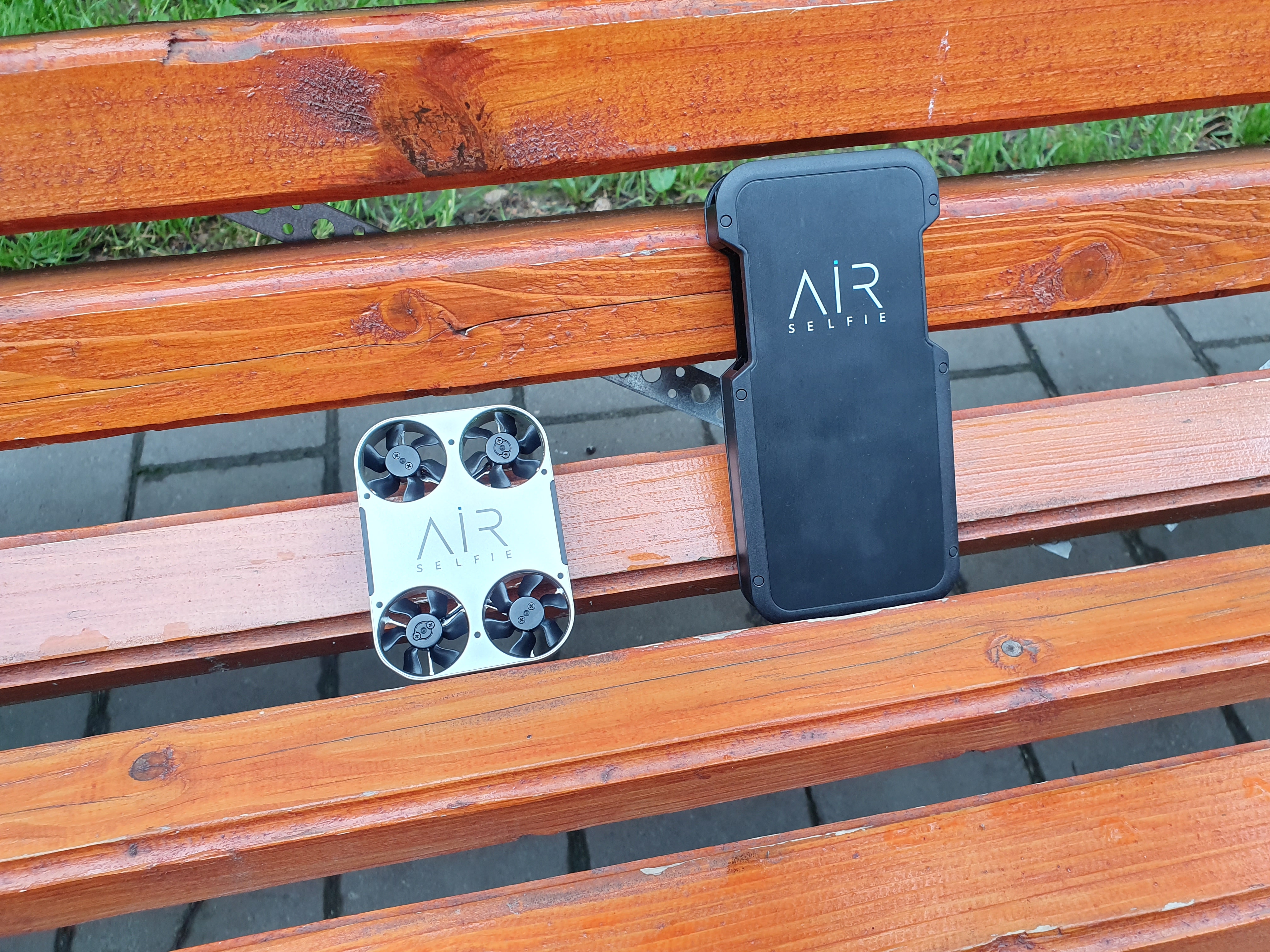
But the main “trick” that was declared by the manufacturer is the ability to take pictures similar to the pictures from the front camera of the smartphone (“self”, selfie). It differs from a smartphone in that the drone can move some distance away, the drone can shoot at eye level or slightly higher, and it can also shoot a group of people.

Hold height is carried out according to sensors located on the underside of the drone. Maximum flight altitude (as well as range) is limited. If the drone moves away from you for some reason, then if you lose the signal, it will emit a nasty signal and slowly decline to land.
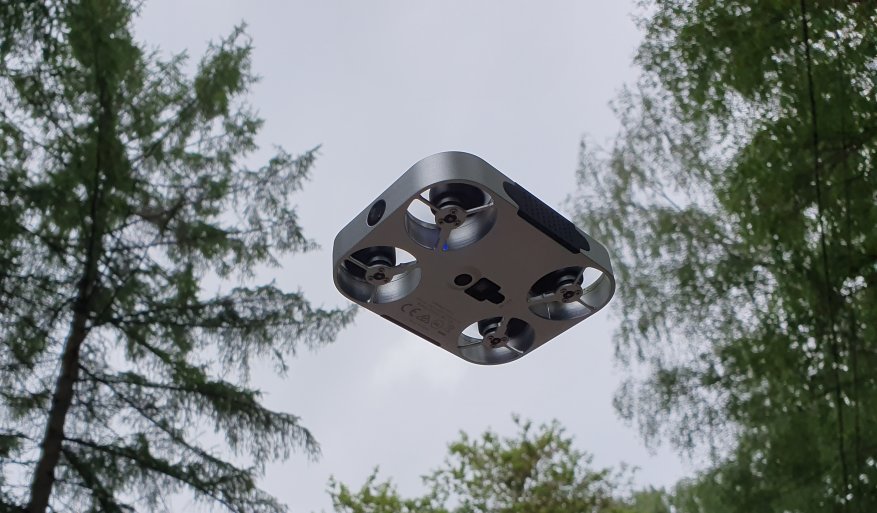
Regarding the characteristics of the camera and the main characteristics of the AirSelfie 2 drone.
A camera with a Sony 12 megapixel sensor with optical (OIS) and electronic (EIS) stabilization is announced, which allows you to shoot FHD 1080p video and take pictures with a resolution of 4000x3000 pixels. The camera has a wide angle of view, and is also installed with a slight downward slope (2 °).

It is possible to set a timer for a snapshot - you can independently pose in front of the drone or gather in a group.
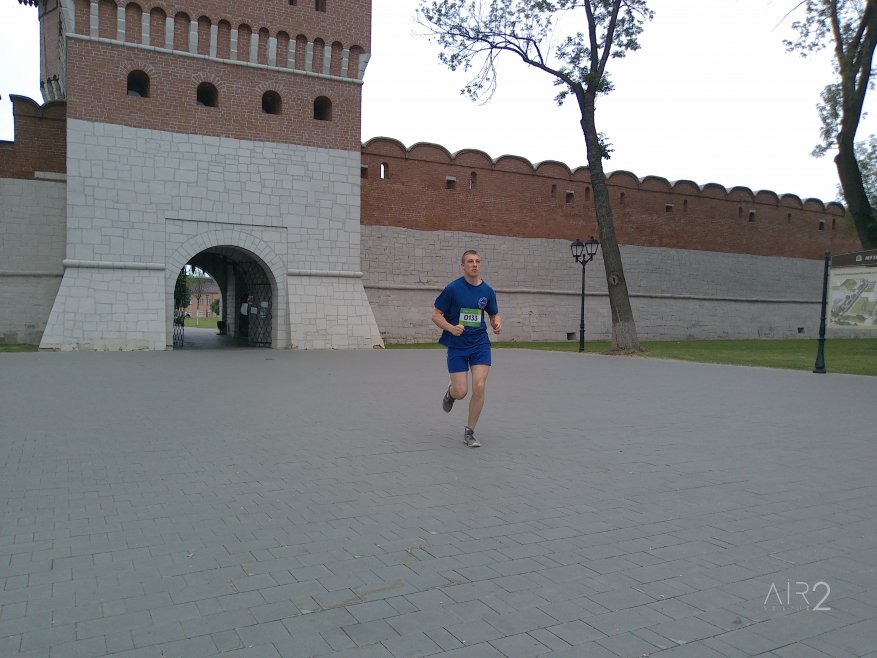
Another example of "self".

File properties of the photo.
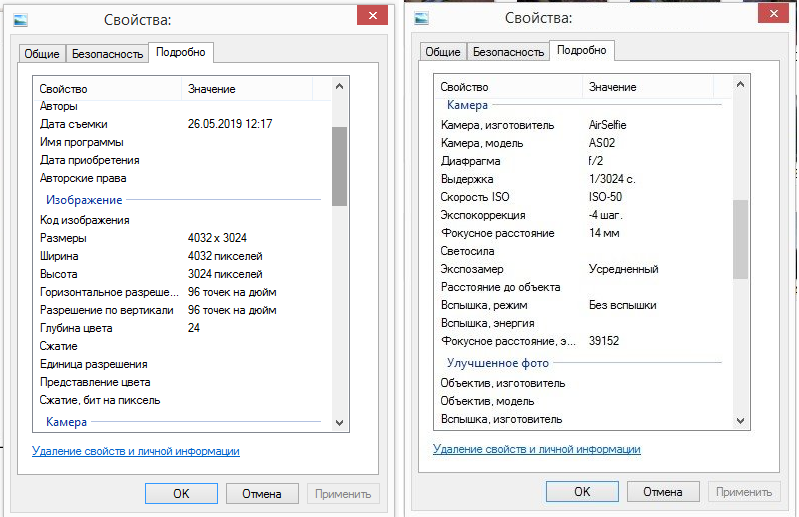
The drone shoots better than its counterparts with FPV microcameras, but it’s far from the quality of huge hexacopters with a mirrorless mirror. True cost more affordable than the latter.
Regarding flight control.
It's simple enough, and AirSelfie 2 just copies ready-made solutions for small FPV / WiFi drones. There are button controls (simple mode), joystick controls and a gyroscope (advanced modes).
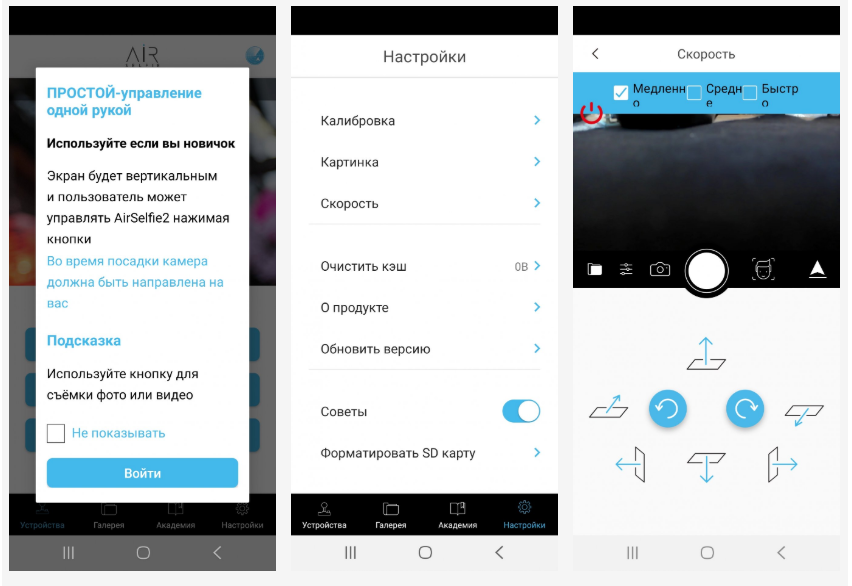
And if the simple mode is more or less clear and convenient, then the control of the gyroscope is quite complex and takes time to get used to. Control two joysticks more convenient.

About the handling.
The drone is very small and light (80 g), the propellers are small - it just cannot fight the wind. Indoors (in large halls), he manifests himself without problems. But in the open space there is a chance not to catch him back.
Due to its compactness, a 2S 7.4V battery is installed inside, of a small capacity that lasts 5 minutes of work. Then back to the case, to recharge.
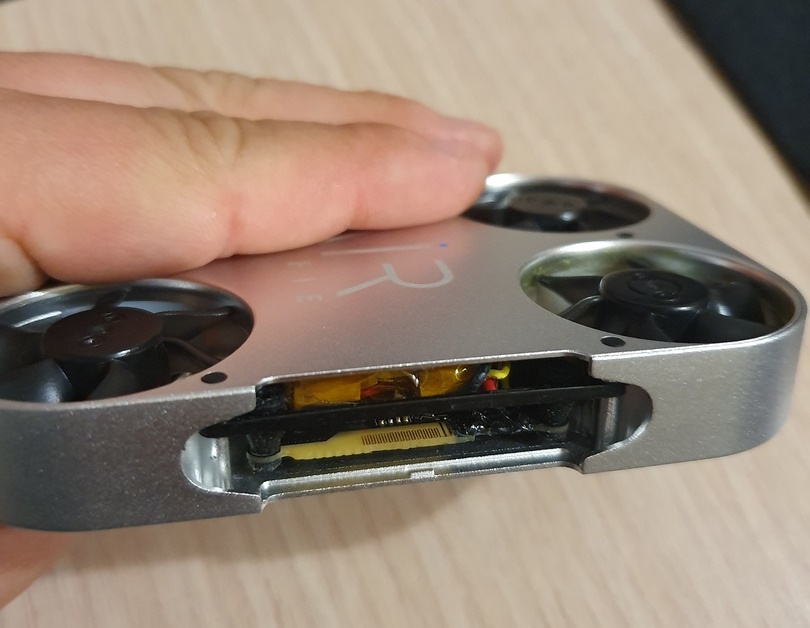
About the case.
I already mentioned above that AirSelfie 2 has a reasonably thought-out solution: a special protective case for transportation, storage and recharging. The drone is installed in its proper place inside the case and is recharged through the USB-C connector. Capacity of the built-in battery in the case of 10'000 mAh. There is a function of the power bank - you can recharge the smartphone.
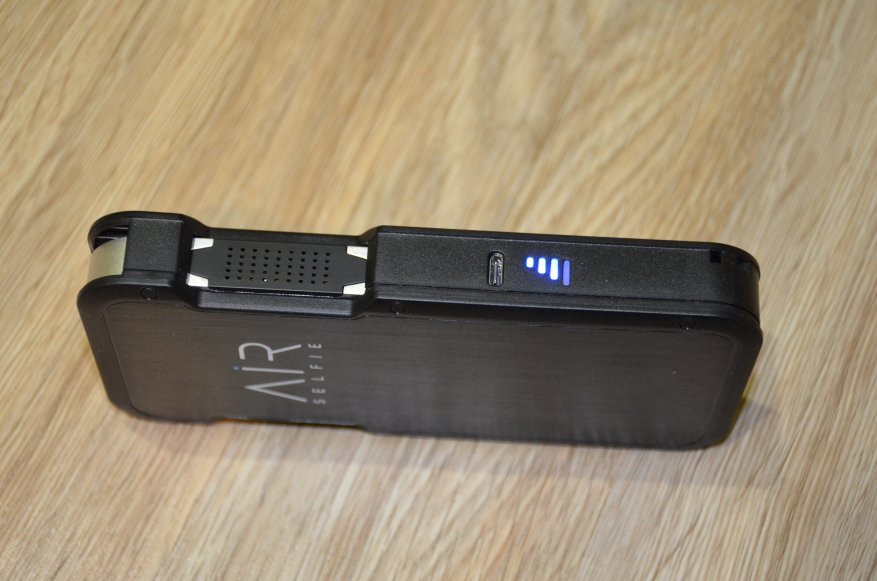
With all the advantages and disadvantages of AirSelfie 2 outweighs the main thing: the drone is very compact and simple. It fits in your pocket. It is easy to take with you for a walk, a trip, even on a plane.
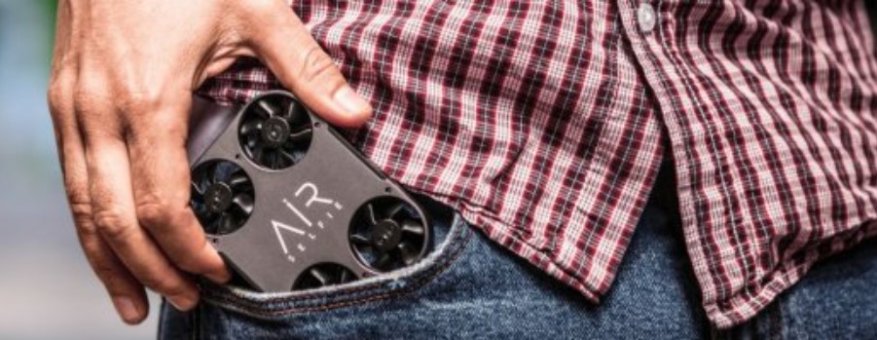
The drone is launched from the hand. Push the start button (the drone spins the propellers) and throws up. Using the sensor, the drone keeps the altitude. You can safely manage it.

So here. At the moment, two “fellows” are serious competitors for AirSelfie 2: this is Tello from DJI and MITU Drone from Xiaomi . Both are equipped with Wi-Fi and automation, but ...
The Xiaomi MITU Drone has a rather weak 2MP camera (720p HD), decently soap and is designed for basic orientation when flying (cheap FPV), while the DJI Tello has a 5MP camera that provides slightly better pictures in the same resolution (720p HD ). Neither the first nor the second has its own memory for storing photos. So you can fly on them, but for self-use is unlikely to succeed.

I attach a short video that gives a little insight on the Airselfie gadget.
And one more thing, I apologize in advance for the vertical video.
This is a spontaneous shooting using AirSelfie 2.
What is the beauty - just start it by tossing it with your hand, twist, twist it as you like.
A big plus is that there is a strong Wow effect. This method of photographing attracts attention.
And most importantly - the flying camera Airselfie will help solve the issue with shooting where the usual camera can not cope. Airselfie is a good opportunity to get great pictures on travel and on vacation. No need to ask anyone - just launch a pocket “camera” in seconds, and get great photos. With a selfie stick like this is not done. And the group moments are successful: everyone is in the frame, no one was missed, no one left with the camera.
On testing drone AirSelfie 2 got from here . There is an option without a charging case .
Please note, there is a promotional code for a discount of 10%: selfiehabr .


So ...
This is a fairly new interesting gadget, which is a small quadcopter with control via Wi-Fi from a smartphone. Its size is small (about 98x70 mm with a thickness of 13mm), and the body is aluminum with propeller protection. Brushless motors are used, propellers are balanced, and several types of sensors are used to maintain height: an optical height sensor and an acoustic surface sensor.
')
Depending on the configuration, AirSelfie 2 can be supplied with a case-external battery. This case is designed to recharge the drone "on the run." Capacity is enough for 15-20 charge cycles.

But the main “trick” that was declared by the manufacturer is the ability to take pictures similar to the pictures from the front camera of the smartphone (“self”, selfie). It differs from a smartphone in that the drone can move some distance away, the drone can shoot at eye level or slightly higher, and it can also shoot a group of people.

Hold height is carried out according to sensors located on the underside of the drone. Maximum flight altitude (as well as range) is limited. If the drone moves away from you for some reason, then if you lose the signal, it will emit a nasty signal and slowly decline to land.

Regarding the characteristics of the camera and the main characteristics of the AirSelfie 2 drone.
A camera with a Sony 12 megapixel sensor with optical (OIS) and electronic (EIS) stabilization is announced, which allows you to shoot FHD 1080p video and take pictures with a resolution of 4000x3000 pixels. The camera has a wide angle of view, and is also installed with a slight downward slope (2 °).

It is possible to set a timer for a snapshot - you can independently pose in front of the drone or gather in a group.

Another example of "self".

File properties of the photo.

The drone shoots better than its counterparts with FPV microcameras, but it’s far from the quality of huge hexacopters with a mirrorless mirror. True cost more affordable than the latter.
Regarding flight control.
It's simple enough, and AirSelfie 2 just copies ready-made solutions for small FPV / WiFi drones. There are button controls (simple mode), joystick controls and a gyroscope (advanced modes).

And if the simple mode is more or less clear and convenient, then the control of the gyroscope is quite complex and takes time to get used to. Control two joysticks more convenient.

About the handling.
The drone is very small and light (80 g), the propellers are small - it just cannot fight the wind. Indoors (in large halls), he manifests himself without problems. But in the open space there is a chance not to catch him back.
Due to its compactness, a 2S 7.4V battery is installed inside, of a small capacity that lasts 5 minutes of work. Then back to the case, to recharge.

About the case.
I already mentioned above that AirSelfie 2 has a reasonably thought-out solution: a special protective case for transportation, storage and recharging. The drone is installed in its proper place inside the case and is recharged through the USB-C connector. Capacity of the built-in battery in the case of 10'000 mAh. There is a function of the power bank - you can recharge the smartphone.

With all the advantages and disadvantages of AirSelfie 2 outweighs the main thing: the drone is very compact and simple. It fits in your pocket. It is easy to take with you for a walk, a trip, even on a plane.

The drone is launched from the hand. Push the start button (the drone spins the propellers) and throws up. Using the sensor, the drone keeps the altitude. You can safely manage it.

So here. At the moment, two “fellows” are serious competitors for AirSelfie 2: this is Tello from DJI and MITU Drone from Xiaomi . Both are equipped with Wi-Fi and automation, but ...
The Xiaomi MITU Drone has a rather weak 2MP camera (720p HD), decently soap and is designed for basic orientation when flying (cheap FPV), while the DJI Tello has a 5MP camera that provides slightly better pictures in the same resolution (720p HD ). Neither the first nor the second has its own memory for storing photos. So you can fly on them, but for self-use is unlikely to succeed.

I attach a short video that gives a little insight on the Airselfie gadget.
And one more thing, I apologize in advance for the vertical video.
This is a spontaneous shooting using AirSelfie 2.
What is the beauty - just start it by tossing it with your hand, twist, twist it as you like.
A big plus is that there is a strong Wow effect. This method of photographing attracts attention.
And most importantly - the flying camera Airselfie will help solve the issue with shooting where the usual camera can not cope. Airselfie is a good opportunity to get great pictures on travel and on vacation. No need to ask anyone - just launch a pocket “camera” in seconds, and get great photos. With a selfie stick like this is not done. And the group moments are successful: everyone is in the frame, no one was missed, no one left with the camera.
On testing drone AirSelfie 2 got from here . There is an option without a charging case .
Please note, there is a promotional code for a discount of 10%: selfiehabr .

Source: https://habr.com/ru/post/455463/
All Articles